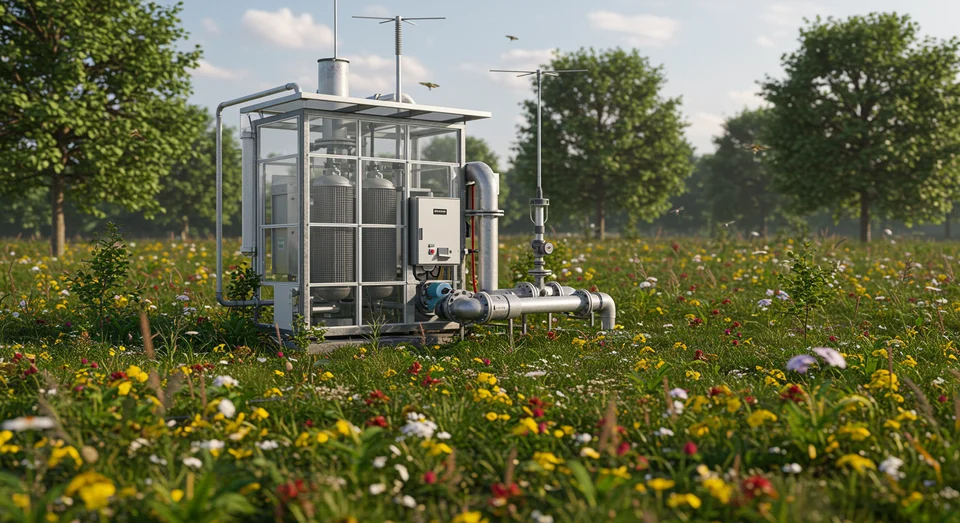Airborne eDNA Breakthrough Transforms UK Pollution Stations into Biodiversity Monitoring Hubs
277 views
In a groundbreaking stride for conservation science, researchers have unlocked a remarkable method to monitor biodiversity on an unprecedented scale by harnessing environmental DNA (eDNA). This technique, which involves collecting genetic fragments shed by organisms into their surroundings, has now expanded its scope to include airborne DNA captured on filter paper at pollution monitoring stations across the United Kingdom. By analyzing these filters, scientists have identified hundreds of species—from insects and spiders to plants, fungi, birds, and mammals—offering a panoramic snapshot of biodiversity across the nation. This innovative approach not only underscores the potential for large-scale environmental monitoring but also hints at transformative possibilities for global conservation efforts.

The Invisible Tapestry of Life: Harnessing Airborne eDNA for Biodiversity Monitoring
The premise of eDNA is deceptively simple yet profoundly impactful. Every organism, from the tiniest microbe to the largest mammal, sheds genetic material into the environment—whether through skin cells, hair, pollen, or other biological detritus. By collecting these fragments from soil, water, or air, researchers can reconstruct a picture of the species inhabiting a given area without direct observation. Traditionally, this technique has been employed in aquatic ecosystems, where water samples yield insights into the presence of fish, amphibians, and other organisms. However, the leap to airborne eDNA represents a significant evolution in the method’s application, opening doors to an entirely new realm of biodiversity tracking.
The ingenuity of the airborne eDNA technique lies in its simplicity. Using filter paper and fans, researchers can capture microscopic traces of DNA floating in the air. These filters, often part of pollution monitoring stations, were originally intended to measure air quality and pollutant levels. Yet, unbeknownst to their operators, the filters were also quietly accumulating genetic material from the surrounding environment. When scientists repurposed these filters for eDNA analysis, they revealed an astonishing wealth of biodiversity—hundreds of species spanning multiple taxonomic groups—offering a vivid snapshot of life across the U.K.
This serendipitous discovery highlights the dual utility of existing infrastructure, turning pollution monitoring stations into biodiversity observatories. The implications are profound: with minimal additional effort, researchers can tap into a ready-made network to collect eDNA data on a national scale. The filters themselves act as silent witnesses to the intricate web of life, capturing genetic traces from organisms that might otherwise go unnoticed in traditional surveys.
Scaling Up: From Local Insights to Global Conservation
What makes this approach particularly exciting is its scalability. Experts suggest that the same principles could be applied to monitor biodiversity across continents—or even globally. By integrating eDNA collection into existing networks of air quality monitoring stations, researchers could create a vast, interconnected system capable of tracking environmental changes in real time. Such a system could revolutionize conservation science, offering a continuous stream of data to inform policy decisions, habitat management, and climate change mitigation efforts.
While traditional biodiversity censuses rely on direct observation, trapping, or sampling—methods that are often labor-intensive and limited in scope—eDNA provides an indirect yet expansive alternative. It may lack the precision of identifying exact population sizes or behaviors, but its ability to capture a broad spectrum of species in a single sweep makes it invaluable for large-scale monitoring. This trade-off between precision and breadth could be particularly useful in regions where biodiversity is under threat or poorly documented, offering a means to detect changes before they become irreversible.
Moreover, the potential for global application aligns seamlessly with the urgent need for comprehensive biodiversity data. As ecosystems face mounting pressures from deforestation, urbanization, and climate change, understanding the distribution and health of species becomes ever more critical. Airborne eDNA could serve as a sentinel, providing early warnings of declining populations or invasive species, and enabling targeted conservation interventions.
A New Era for Conservation Science
The implications of this research extend far beyond the immediate findings. By transforming pollution monitoring stations into biodiversity hubs, scientists are reimagining the tools and infrastructure at their disposal. This shift reflects a broader trend in conservation science: the integration of technology and interdisciplinary approaches to tackle complex environmental challenges. From satellite imagery to machine learning algorithms, the field is increasingly embracing innovative methods to capture the dynamic interplay between species and their habitats.
However, as with any emerging technology, airborne eDNA comes with its own set of challenges. The technique’s reliance on genetic fragments means that it offers a snapshot rather than a detailed census, and the data must be carefully interpreted to account for variables such as wind patterns, seasonal changes, and local environmental conditions. Additionally, scaling up the approach will require coordination across borders and institutions, as well as standardization of methods to ensure consistency in data collection and analysis.
Despite these hurdles, the promise of airborne eDNA is undeniable. By transforming invisible genetic traces into actionable insights, researchers are not only expanding the scope of biodiversity monitoring but also redefining what is possible in the realm of conservation science. The technique’s ability to capture the unseen threads of life offers a powerful reminder of the interconnectedness of all species—and the urgent need to protect the delicate balance of ecosystems worldwide.
In the end, this innovative approach serves as both a scientific breakthrough and a call to action. As researchers continue to refine and expand the use of eDNA, the hope is that it will inspire a deeper commitment to preserving the natural world. For in the fragments of DNA collected on a humble filter lies the story of life itself—a story that, if carefully read, could guide humanity toward a more sustainable future.



















